The Tiniest Black Hole In The Milky Way Was Right There All Along
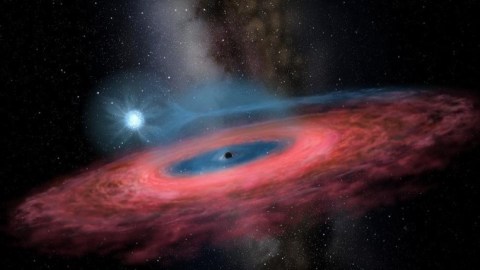
At just 3 solar masses, it eliminates the “mass gap.”
Searching for black holes is one of the most difficult astronomical games a scientist can play. Emitting no light of their own, it’s only through their indirect effects that we can know of their existence. Some black holes act as gravitational lenses, distorting and magnifying the light emitted from background objects, revealing their existence. Others rip nearby matter apart, creating electromagnetic emissions ranging from radio waves to X-ray light. And some black holes merge together with others, leading to gravitational waves that ripple across the Universe.
But the very first method we ever developed for finding black holes was to look for stars with a massive but unseen binary companion. When black holes orbit a large star, they can siphon mass off of them, leading to the emission of X-rays, which we can then detect. This led to the discovery of Cygnus X-1, the first black hole known to humanity. But having a black hole companion could lead to other consequences that affect the light of the normal star. In a first, astronomers think they’ve used those telltale signals to identify the closest, lightest-mass black hole in the entire Milky Way, so far. Here’s the story of this cosmic unicorn.
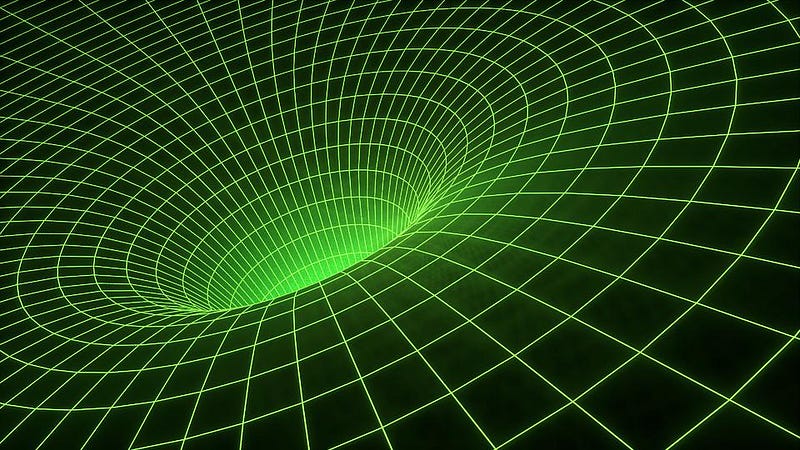
One of the biggest challenges for astronomers is answering the most basic astronomical question of all, “what’s out there in the Universe?” Instinctively, if we want to know the answer, we’d simply look out into space and record what we see, but that would lead to a biased answer. For example, if we were to look at the stars we can see in the night sky, we’d discover that a large fraction of them were bright, blue, young, and relatively far away: hundreds or thousands of light-years distant. In reality, most of the stars that are out there are dim, red, old, and exist at all distances; they’re simply more difficult to see. In fact, the closest star to our Sun, Proxima Centauri, wasn’t discovered until the 20th century; it’s so intrinsically faint that it’s barely been known for 100 years.
For black holes, the story is similar. We see their presence when they have a binary companion star that gives up mass that then accretes onto the black hole, resulting in the emission of X-rays. They reveal themselves to us when they merge with other black holes, emitting gravitational waves that our detectors, like LIGO and Virgo, can pick up. But these are cosmic rarities, and don’t represent the majority of black holes that must be out there. They’re just the easiest ones to proverbially “see.”
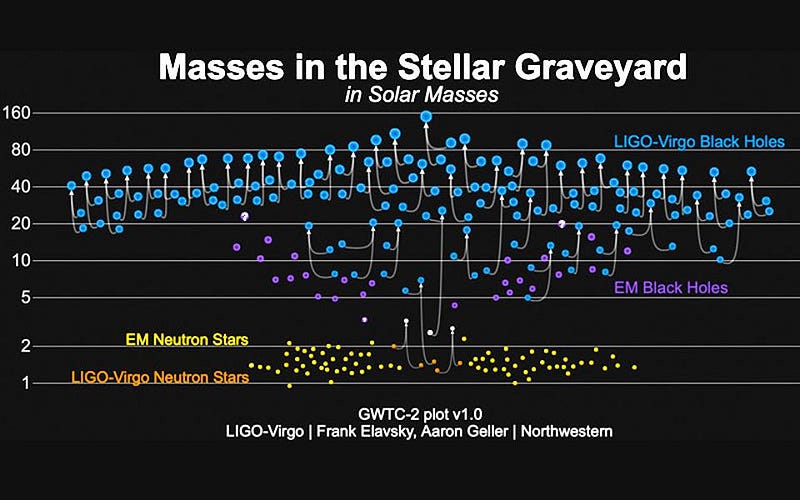
If we could somehow know about the existence of every black hole in the Milky Way, that would teach us an enormous amount of information about the past and present of our Universe. If we could measure each black hole that were out there — and know information about it, like perhaps its mass and/or its age — we could gain a tremendous set of knowledge. In particular, we would learn:
- about the history of massive stars that formed in the galaxy’s past,
- what fraction of stars that once existed led to the formation of black holes,
- what the mass range and distribution of these black holes are,
- and whether black holes are more likely to form from single-star, binary-star, or many-star systems.
Because black holes are typically so electromagnetically quiet, emitting no light of their own, we have to rely on the influence of the other objects surrounding them to reveal their presence. But even in the absence of gravitational waves or large X-ray (or radio) signals coming from them, there may be a way to know that they’re there.
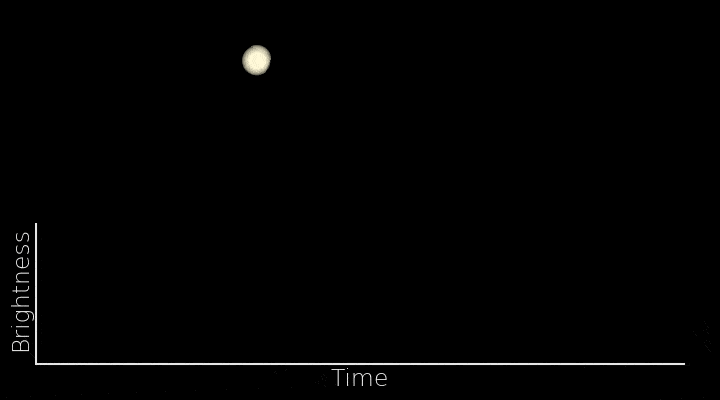
When we look at the individual stars we find in the night sky, most of them appear just as that: as individual points of light. But appearances can be deceiving. When we look more closely at the stars we see, we find that only about half of them are actually stars like our Sun: single stars. The other 50% of stars are bound up as part of multi-star systems, with binary systems being the most common, but trinaries, quaternaries, and higher representing a significant fraction of what’s out there.
Each star — to the best of our astronomical knowledge — has its eventual fate largely determined by the mass it was born with. (Although yes, environmental interactions can alter that fate, and sometimes do.) The more massive stars will burn through their fuel faster, swell into a red giant in short amounts of time, and then, if they’re massive enough, begin fusing carbon in their core. Once that process begins, the star quickly burns through the subsequently produced nuclear fuel extremely quickly, before (typically) ending its life in a type II supernova.
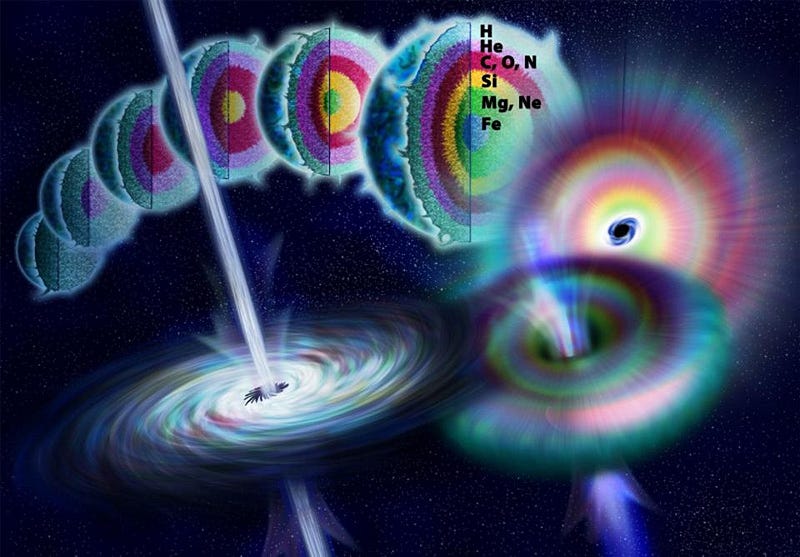
For the less massive stars that undergo a type II supernova, a neutron star will be the result. Neutron stars are typically only about 10–20 kilometers across, but have similar masses to our entire Sun. It’s as though nature took the equivalent of a full-grown star, all on its own, and compressed it so tightly that:
- the electrons that orbited atoms got “pressed” into their atomic nuclei,
- the energies were so large that the electrons fused with protons, producing neutrons and neutrinos,
- those neutrons became bound together through the strong nuclear force,
- with so much gravitational binding energy that they cannot radioactively decay,
- leading to an object that’s even denser than a uranium atom’s nucleus, but with the physical size of a large city.
If the core of a massive star is up to a little more than twice the mass of the Sun — requiring an initial total mass of about ~15 solar masses or so — then a neutron star will be the expected fate.
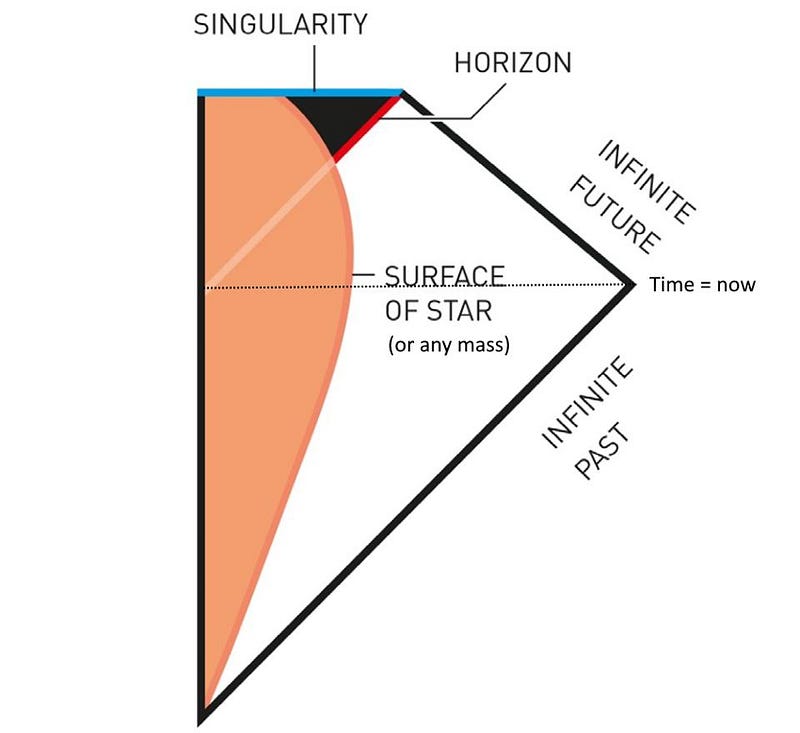
But at higher masses, that dense ball of neutrons will become unstable. Somewhere, near the very center of this object, enough mass gets concentrated into a minuscule volume that no signals — not even at the speed of light — can successfully travel from an interior region to a more outer region: the escape velocity is simply too great. When this occurs, an event horizon forms, which leads to the formation of an astrophysical black hole.
Beyond a certain mass threshold, both for the initial star and for a remnant like a neutron star, the eventual formation of a black hole becomes inevitable.
If the black hole arises from a singlet star system, there won’t be any possibility of seeing the telltale signals that teach us about the presence of black holes. Without a binary companion, there can be no mass siphoning, no inspiraling and merging, and no emission of X-rays or radio waves. Our only realistic hope of observationally detecting this population of black holes, in fact, is from either observing their gravitational effects on background light or from their effects on a randomly-passing star. If a star traveling through interstellar space happens to pass too close to the black hole, it can potentially result in a tidal disruption event, tearing the star apart and causing a spectacularly bright, transient burst of light.
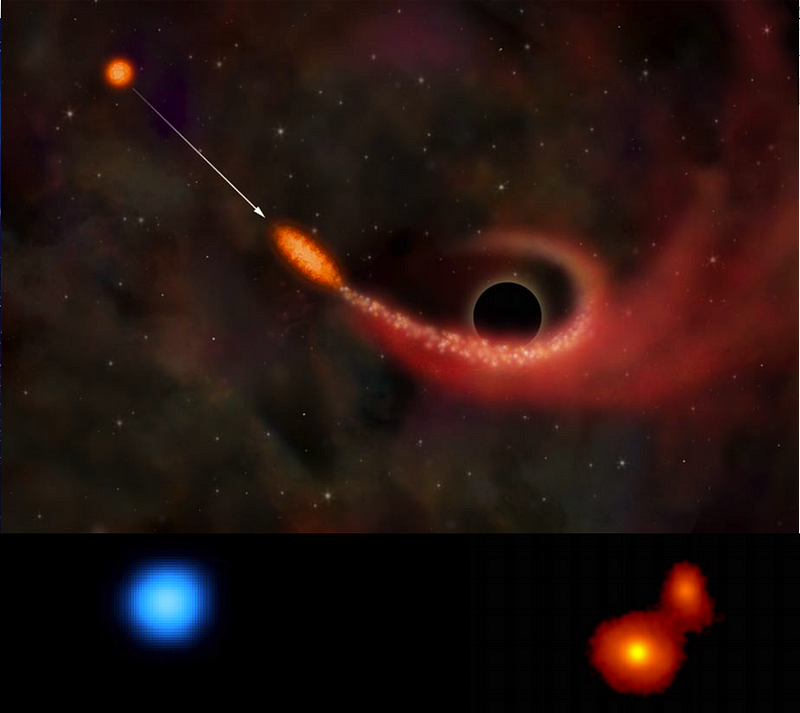
But if your black hole is a member of a multi-star system, you might not need to get as lucky. Yes, there are the X-ray emitting binaries, where one member is a black hole, but those are the vast minority. Black holes only interact and are active when three conditions are met:
- the system is compact, meaning in a very tight, fast orbit,
- the stellar member is large and diffuse, in an evolved giant or supergiant stage in its life,
- and when mass transfer is actively occurring.
This is an extreme minority of binary systems, even of binary systems including black holes. In most instances where one object is a star and another is a black hole, that system will be “quiet” in the signals we normally use to reveal them.
The place that makes the most sense to start our search would be in a system where these three conditions are almost met. A system with a compact, tight orbit, where one star is on the larger side, could have the other member actually be a black hole. There’s only one problem. We already would have categorized it that system as being something else, an eclipsing binary.
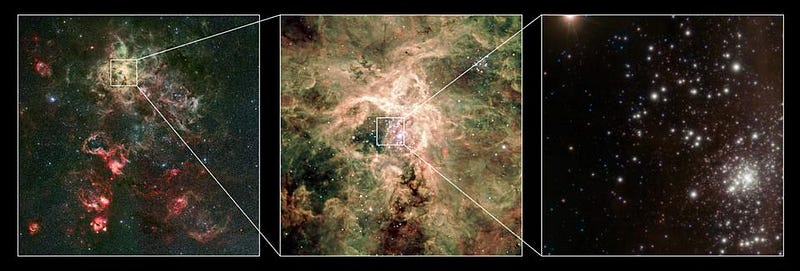
Sometimes, the stars that we look at, even with the most powerful telescopes we have, only appear as a single point of light in the sky. We cannot resolve them as anything other than one point, even though there may actually be two or more members inside.
You might wonder, upon reading that, “how can we know that there’s actually a second object in there?”
The answer is straightforward: the brightness coming from those stars will vary in a particular way over time. When the two stars are separated from one another along our line-of-sight, we see the full disk of both of them, meaning we get 100% of the light we typically receive from both stars. But when there’s a partial or complete overlap, the disk of one star blocks the light from the other, and we see a “dip” in the amount of light we get.
This periodic behavior reveals the presence of an eclipsing binary: an exciting find for stellar astronomers and a troublesome source of noise for exoplanet hunters. But, under the right conditions, there could also be a third explanation for this behavior: a binary system where one member is a black hole.
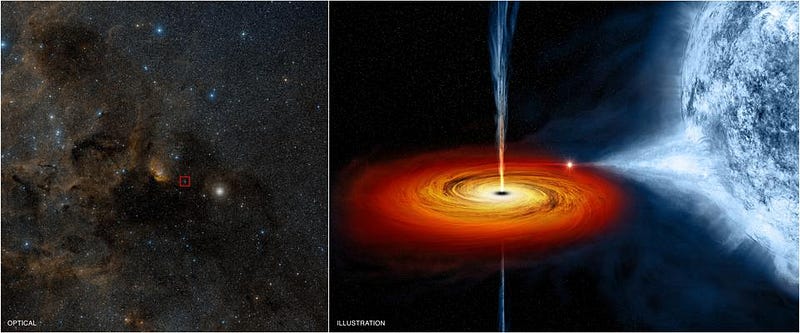
We know, astronomically, how stars work. If you have a star of a certain mass, we know what its brightness ought to be, particularly if we know where it is in its stellar life cycle. Similarly, we know how gravity works, and when we see a star orbiting another one, we can infer the masses in the system from the motion of the luminous object(s) through space.
What you’d want to look for, then, is a system that’s been classified as an eclipsing binary, but where one star supplies virtually all of the light compared to the other, and where the other one is more massive than about 2.5-to-2.75 solar masses, ruling out the possibilities that it’s a white dwarf or a neutron star. In such a case, you’d not only expect the faint object to be a black hole, but you’d have another test you could perform: looking for a low, but non-zero level of X-ray emissions, suppressed by a factor of about ~1 billion over the active binary black holes.
In January of 2021, Tharindu Jayasinghe led a new study, using precisely this method to identify what’s now the closest, lowest-mass black hole candidate in the entire Milky Way: a black hole orbiting the red giant star V723 Monocerotis, a star in the constellation of Monoceros, the unicorn. Instead of a star, this red giant appears to be orbiting a black hole of 3.0 solar masses, with X-ray emissions that are just one-billionth of the maximum brightness you’d expect from the accretion of matter. It’s just ~1500 light-years away, making it the second closest black hole presently known, and at 3.0 solar masses, would be the lightest black hole ever found in our galaxy.
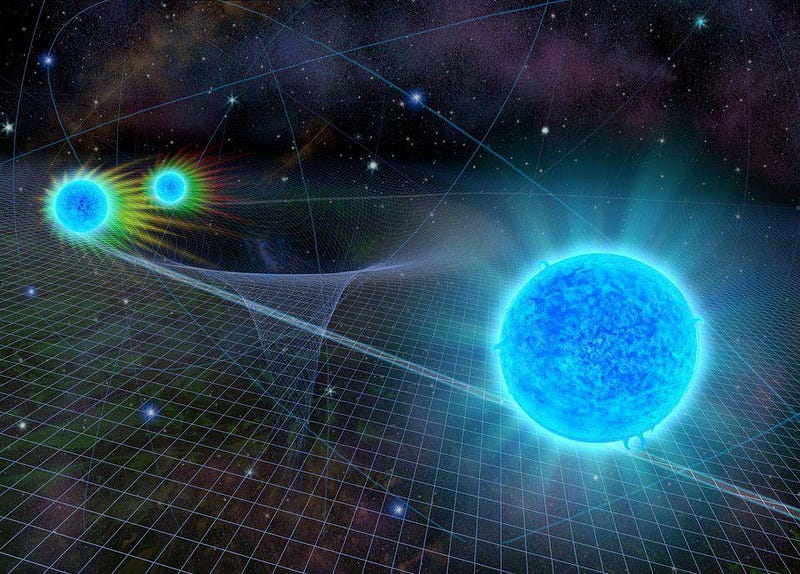
Our view of the Universe is always going to be plagued by this simple fact: the easiest things to see with the methods we have of looking are going to be the things we see the most of. But that doesn’t necessarily tell us what’s actually out there. To detect objects that may be abundant but that aren’t immediately apparent, we have to identify what signals would actually reveal them, and then interrogate the Universe in precisely that fashion. When we do it successfully, we can wind up finding objects we’d never have revealed otherwise.
For generations, astronomers have wondered where all the expected black holes in the Universe are. They’ve wondered just how low in mass they can get, and what types of star systems possess them. With this new information about the red giant star V723 Monocerotis, and its three-solar-mass, non-luminous but light-blocking companion that emits a small amount of X-rays, we’ve likely uncovered the tip of a cosmic iceberg here. Black holes are likely abundant at these low masses in binary systems, and may make up a substantial fraction of systems that had previously been identified as eclipsing binaries.
Sometimes, the biggest discoveries come by taking a closer look at the things you already know about. The Milky Way’s lowest-mass black hole, just three times the mass of our Sun, has just been revealed, and it’s only 1500 light-years away. Perhaps, with similar techniques, we might finally uncover just what kinds of stars lived-and-died in our Milky Way throughout its entire history.
Starts With A Bang is written by Ethan Siegel, Ph.D., author of Beyond The Galaxy, and Treknology: The Science of Star Trek from Tricorders to Warp Drive.





